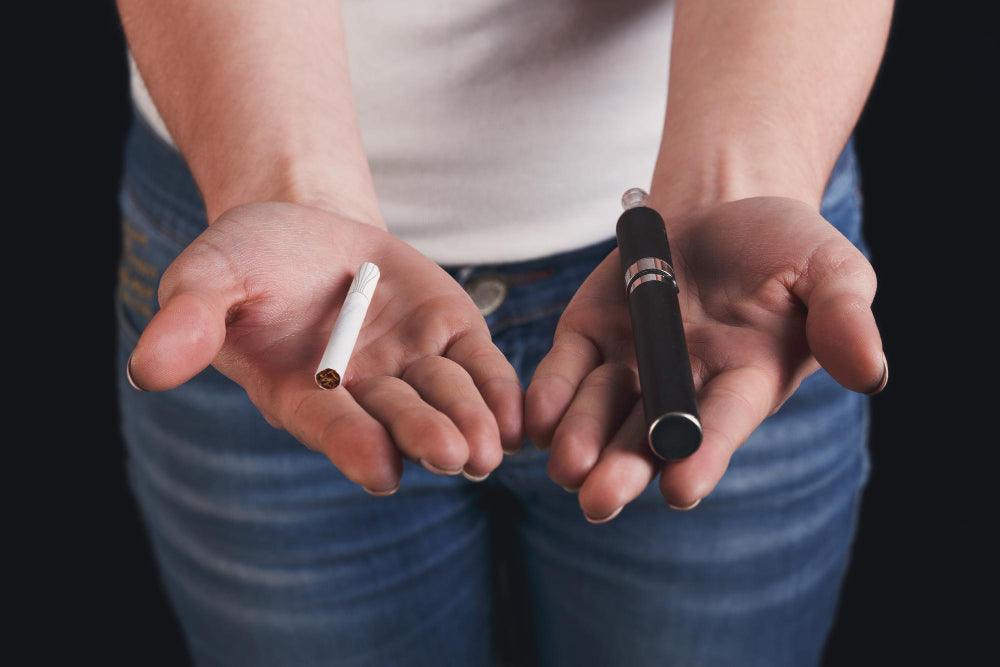Smoking vs Vaping: Differences & Impact on your Health?


Both vaping and smoking have hazards and adverse effects. According to scientists, electronic cigarettes (e-cigarettes) are not a safe substitute for smoking. However, the medical community does not entirely understand the long-term health implications of e-cigarettes.
Vapers inhale an aerosol containing numerous compounds through an e-cigarette or other vaping device, including nicotine and flavouring. The various flavours available are why teenagers are becoming more interested in vaping.
According to the AHA, many individuals feel that vaping is a safer alternative to smoking, yet this is not always the case. In addition, vaping appears to be harmful, as per the mounting data. This article will compare smoking and vaping and learn about the long-term impact and risks of both.
For those seeking to quit either habit, turning to reliable, clinically supported tools is key. Welzo's Stop Smoking Collection offers a wide range of expert-backed aids—such as nicotine lozenges, gum, sprays, and prescription medications—to help individuals reduce cravings, manage withdrawal symptoms, and successfully transition to a smoke-free life.
The liquid is heated and converted into an aerosol (vapour) during the vaping process, which the user inhales. Additionally, there are two types of vaping devices, sometimes known as e-cigarettes. More complicated tank devices, as well as discrete pod devices or vape pens, fall into this category.
The liquid included in e-cigarettes and vape devices is known as vape juice. An internal coil warms the liquid and transforms it into a vapour which becomes breathable when heated by the device's battery. E-liquids are available in many flavours and may or may not contain nicotine. Tobacco is not present in vape e-liquids. However, they may be engineered to taste like it.
Vaping can be highly addictive due to its nicotine content and customizable sensory experience. The pleasant flavours and lack of the harsh tobacco smell make it more socially acceptable and even appealing, especially to younger users. This is why quitting vaping can be just as challenging as quitting cigarettes.
For individuals transitioning away from vaping or smoking, tools like the Nicorette Original Gum offer effective support. This gum delivers controlled nicotine doses while satisfying the oral fixation associated with smoking and vaping rituals.

By far, the most prevalent way for people to consume tobacco and sustain their nicotine addiction is by smoking. Inhaling the vapours of burning tobacco plant material is known as smoking. Tobacco contains nicotine, an addictive chemical with stimulating and soothing psychoactive effects.
There is a wide range of tobacco products available, and while cigarettes are by far the most common, they are far from the only way to inhale tobacco smoke. Most of these techniques and products date back when cigarettes were not widely available, but they have proven to thrive and maintain a vast user base.
A cigarette is a tobacco roll. Almost all items wrapped in thin paper or something else that does not include tobacco are referred to by this term. Cigarettes are the most widely used nicotine delivery technique in most developed countries, with cigars and other tobacco smoking items taking over only in Cuba and India, where hookahs are favoured.
For some reason, most individuals believe that smoking cigarettes labelled as 'light,' 'mild,' or 'ultra' lower health risks. Unfortunately, there is not a scrap of proof to back this up. The same goes for menthol cigarettes. They include chemicals made to taste like peppermint and spearmint plants, and when smoked, they produce a cooling effect.
Pipes and cigar smokers frequently argue that by avoiding cigarettes, which they believe is the most dangerous nicotine delivery technique, they avoid the most severe health risks associated with tobacco use.
Vaping heats liquid to create vapour, while smoking burns tobacco to produce smoke. Because cigarette smoke contains over 7,000 chemicals—many of them toxic—vaping can significantly reduce exposure to harmful substances. However, that doesn’t mean it’s harmless.
For those using vaping as a way to quit smoking, products like the Nicorette QuickMist SmartTrack Spray provide a smarter, fast-acting alternative. It delivers quick nicotine relief and tracks your usage digitally, supporting more mindful quitting.
According to the evidence, smoking cigarettes appears to be more dangerous than vaping. This does not, however, imply that vaping is risk-free.
More than 7,000 compounds are found in second-hand smoke, from cigarettes, inhaled by bystanders. Hundreds of these compounds are poisonous, with about 70 of those compounds causing cancer. According to the American Heart Association, although vaping liquids contain fewer toxins than cigarettes, they are not entirely safe.
Unlike vaping, which is still relatively new, years of research-backed allegations proclaim that smoking is harmful to human health. According to the Centers for Disease Control and Prevention (CDC), smoking results in:
Vapers may be at risk due to the following factors:
E-cigarettes produce aerosols that can contain nicotine, flavouring or other chemicals. Regular tobacco cigarettes contain many more harmful substances and some are toxic to health. While it's not clear exactly how many chemicals are present in an e-cigarette, it is pretty clear why smoking an e-cigarette is safer. However, there have been a number of lung infections and fatalities reported directly related to vaping. So be careful not to qualify vaping as a 100% safe practice. In addition to traditional NRTs, some people explore filter alternatives like the Crafe Away Anti-Smoking Filters. These are designed to reduce harmful tar and nicotine intake from cigarettes gradually, supporting a phased quit strategy.
The National Institute for Health and Care Excellence even suggests that using E-cigarettes can assist smokers in stopping the habit. They claim that research has shown that e-cigarettes are considerably less harmful than cigarette smoking. However, they do not know the long-term effects of e-cigarettes on one's health.
According to the NHS, 78,000 people in the UK die from smoking yearly. In addition, many smokers live with debilitating smoking-related illnesses.
Smoking has several long-term health consequences. According to the CDC, smoking:
While research shows that vaping can affect the lungs and other body systems, it has less impact than tobacco smoking. However, as mentioned above, the long-term effects on one's physical health are mostly unknown.
Vaping has the potential to:
Some users have also reported battery explosions, highlighting the importance of device safety and regulation.
To help reduce dependence on vaping, tools like NiQuitin Minis 4mg Mint offer a discreet and fast-dissolving nicotine option that’s ideal for people transitioning from vape to full cessation.
After the coronavirus pandemic started in 2019, Reports showed that sales of cigarettes decreased. The rise in the consumption of e-cigarettes in general affects a number of e-cigarette users. The rate of people vaping each day was 1 in 5, however that has increased somewhat which may cause more nicotine addictions. Vaping, smoking, or other lung irritants are known as contributing factors to COVID-19 respiratory conditions.
Smoking and vaping both present health risks—some understood, some still under investigation. Smoking, with its long-standing track record of harm, is clearly more dangerous, but vaping should not be considered risk-free. Fortunately, a wide array of solutions exists for those ready to quit, including tools featured in the Nicotinell Collection, which offers proven gum and lozenge options to ease the transition away from nicotine.
If you're seeking more targeted oral therapy options or lozenges, explore the Nicotine Lozenges Collection to find a flavour and strength that fits your quit plan.








Plus get the inside scoop on our latest content and updates in our monthly newsletter.